All about watering your lawn
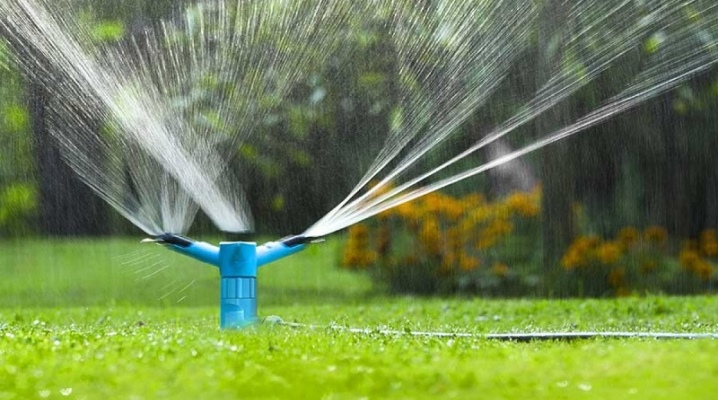
Watering the lawn is an important measure in the proper care of the site. Failure to comply with the rules for moistening lawn grass can lead to the death of the green surface, and this will immediately make your territory unattractive in terms of landscaping.
Sufficient moisture allows useful grass to accumulate strength to resist diseases, overcome weeds, and ultimately give the area around the mansion an aesthetically beautiful and well-groomed look. We will tell you in detail how to establish optimal irrigation of the green surface.
Signs of lack of moisture
Without water, not a single blade of grass will grow - everyone knows that. Watch how, in a dry year, lawns near highways, around high-rise buildings, or in parks where the irrigation system is not established, perish. It should be noted right away that excessive moisture for rolled lawns is not normal. Waterlogging of the soil leads to the development of mold and the appearance of pathogens. But the lack of water in the soil will lead to the death of the grass. If, for example, bluegrass takes on a gray-bluish tint, it urgently needs to be shed. Otherwise, the dried grass will curl up and dry out. Do you see such a picture? Immediately turn on the water supply to the lawn to reanimate it.
How else to understand that the lawn needs moisture? Experienced homeowners determine the condition of a coating based on the firmness of the grass. Juicy, well-moistened blades of grass, even after stepping on them, will quickly regain their shape. But dry grass will not do this.
So if at least 1/3 of the lawn looks crumpled after walking on it, then it's time to refresh it and arrange a shower for it. Most often, the grass itself tries to "convey" to the owner that it is time to wet it.
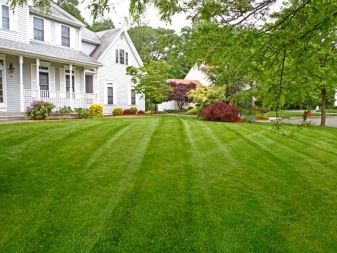
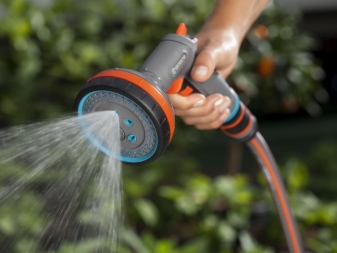
It remains only to pay attention to the following signs:
- folding and wilting of blades of grass;
- the lawn is trampled down (it takes a long time to return to its original form after walking on it);
- green grass takes on a brown tint;
- yellowness appears on the lawn;
- a covering with bald patches is a clear sign of a lack of moisture in the soil.
On the old lawn, the wilting of the grass is most noticeable. It is especially necessary to monitor the watering of the common bluegrass and the white bent grass. Not so whimsical, but still do not forget to moisturize meadow bluegrass and chaff in a timely manner. But if you forgot to water the fescue on time, she is ready to endure while you remember. For drought-resistant grasses, lack of water is not a catastrophic situation. They survive even when the roots and leaves dry out. The plant itself goes into a state of dormancy and as soon as it receives the long-awaited "drink", it begins to recover.
But still, this state of affairs should not be allowed, since the appearance of greenery during drought leaves much to be desired in any case: you are unlikely to be pleased with a faded and yellowed coating. It is best to do everything on time and respond to signals from the grass.
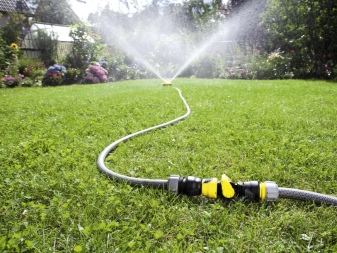

When and how often to water?
In theory, watering the lawn should be done when the soil is 10 centimeters deep - in practice, you will not poke around in the ground every time to establish these centimeters. Therefore, the reference point is the appearance of the lawn: the grass grows dull, has changed its shade to gray or brown, has lost its elasticity, it is necessary to start the irrigation system. In the summer, in the heat, you need to watch the rolled lawns, especially those that have recently been laid.Unlike sown lawns, their root zone is in the uppermost layer, so such a covering will suffer from a lack of moisture.
If the sod has not yet had time to attach well to the soil, then in these places the grass will instantly turn yellow if it is not watered in time. The frequency of watering, of course, primarily depends on the weather, and secondly on the type of soil on which the grass is sown or the green roll is laid. In cool weather with variable cloudiness, watering can be done 1 time in 7 days, and maybe even at 10. In hot dry weather and on loose sandy soils, you will need to moisten the green massif every day. It is necessary to start watering in the spring when it is 12-15 degrees Celsius outside. In cool conditions at +10 degrees, irrigation will be ineffective, and maybe even destructive for a lawn that is not strong after winter. By time it is best to water in the evening hours (16: 00-18: 00), later it is no longer recommended - the grass needs time to dry out.
If it is wet all night, this will affect the condition of the cover - so shortly before the fungal disease. And in the heat, watering is recommended in the mornings (6: 00-9: 00) and in the evenings, but in no case do this during the day in the very heat. Irrigation in the heat is detrimental to plants. Daytime watering is allowed only in cloudy weather or a warm autumn period. Otherwise, wet grass under the scorching sun can burn. Watering is stopped completely in October on the eve of the first frost.
You are guided by the weather: it is better to turn off the irrigation system earlier - in a week or two - than the frost will catch strong moisture in the soil.
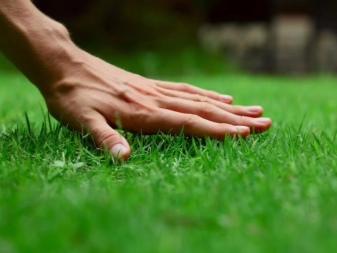

Equipment overview
Irrigation equipment is chosen based on the area of the green area, the location of the lawn, its shape and other indicators. It can be automated or in the form of manual irrigation tools. Let's take a closer look at the most common elements.
Watering cans
From a watering can you will pour a small coating, but it will take a lot of effort. This is a very time consuming process. If there is running water on the site, it is better to simplify your task and use other methods. But do not hide the garden watering can. It will be needed for watering problem areas, as well as places where the hose will not reach or the jet will not reach.
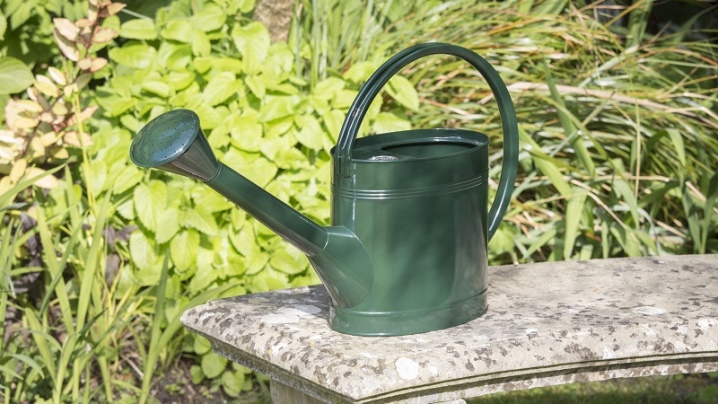
Hoses
Hose irrigation is a simple and versatile approach to irrigating home lawns. It can be used if there is a nearby reservoir or water supply on the site. In the first version, this can be adjusted using a pump (by the way, it can also pump out water from the container). In the second, you can do without automation, and buy various nozzles for the hose.
It is best to purchase special garden sprayers. With such devices, you can quickly and efficiently water the lawn without wasting your time, and most importantly, moisture will be distributed evenly throughout the array. Such systems are of various types.
- Stationarywhen the hose is installed underground and irrigation is carried out using the retractable nozzles. By changing the nozzles that rise above the soil surface at the time of irrigation, a jet of different power and shape is obtained.
- Mobilewhen hoses can be moved from one place to another. This type includes a drip hose design with small holes along its entire length.
It all depends on the capabilities and preferences of the homeowner, his material wealth, as well as on the configuration of the green array. For huge lawns, an underground installation is suitable.
For small and narrow, but long - drip designs, for round and oval coatings - with pulsating jet nozzles.
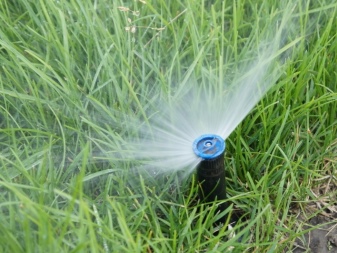
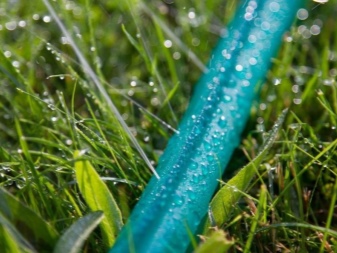
Sprinklers
The sprinkler lives up to its name - it is a device that turns a powerful stream of water from a hose into rain through special nozzles-diffusers and nozzles-spray nozzles. Such an installation softens the powerful jet and does not allow it to destroy the coating surface. True, with such irrigation, water evaporates: the smallest drops of water are weathered. But if you install several circular sprinklers in a small area, then, in addition to excellent watering of the area, you will also get aesthetic pleasure, enjoying the "fountains" in your yard.
The rotating sprinkler allows you to adjust the stream and set the distance, for example, so as not to flood paths, swings, and other objects. There are also swinging and oscillating sprinklers. They were invented for square and rectangular lawns. Through them, you can adjust the irrigation range and intensity.

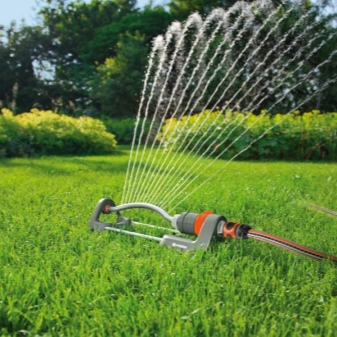
Other
An automatic irrigation system will help to keep the grass cover in order. It is installed before they plan to sow or lay the lawn - this is due to the fact that pipes, hoses need to be laid underground, pumps, sprinklers, rain sensors, tensiometers and other elements need to be installed. Unlike simple hose systems that operate on a jet of water, for which it is enough to open the tap, the autowatering system needs electricity, that is, choose a convenient place to find the outlet and the entire power supply.
Autowatering can be controlled by a computer program, which greatly facilitates not only the irrigation process itself, but also control. You only need to select the desired program. It is better to invite specialists to calculate and install such systems. Despite the fact that such a system is much more expensive, it will pay off during operation, since less water is spent with automatic irrigation.
Efficiency, low energy consumption and at the same time high quality of irrigation and always good condition - what the owners of such systems note.
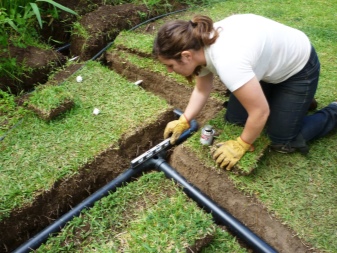
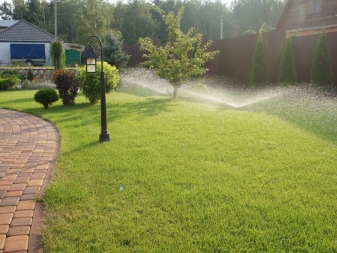
Watering
The first question on the care of the green surface that worries beginners: when watering the lawn, how much is the norm per 1 m2? So, it depends on the composition of the soil and the degree of its drying. The average consumption for irrigation of one square meter of such an array is 10-20 liters of water. If you do watering with your own hands and fill the watering can with cold water from a well, then don't get to work right away, let the water temperature equal the ambient temperature, so that the green shoots get less "stress". The same applies to water, which sometimes accumulates in the hose under the sun - it must be drained so as not to burn the grass.
By the way, knowing the area of the lawn and how many liters your watering can (its volume), you can very easily calculate how much your lawn will "drink". A when the sprinklers are installed, in order to properly irrigate the lawn grass, you can make the calculation as follows:
- distribute several glass jars of 0.5 liters over the area;
- start watering and monitor the level of filling of the cans;
- filling at the level of 1.3 centimeters shows that 10 liters have already poured out on 1m2;
- filling at the level of 2.5 centimeters shows that 20 liters have spilled out on 1 m2, and so on.
There is no need to “play” with the jars every time - once will be enough to properly organize the irrigation scheme in the future: count how long it will take at different positions of the sprinkler to fill the jars to a certain level and, focusing on this time, simply move the unit to a different location.

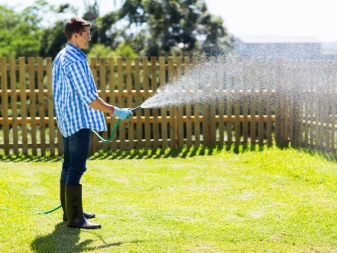
On clay soil, the watering rate is reduced, since the clay retains moisture well. Where there is loose sandy soil, you need to water more often and increase the rate. If you live in the middle lane, then to irrigate your lawn, use 20-40 liters of water per 1 square meter of the array. There, precipitation is a rare occurrence, and therefore it is necessary to water abundantly. Experienced homeowners find it better to irrigate their lawns less frequently, but vigorously, rather than little by little. However, it is necessary to observe moderation, make sure that water does not accumulate on the surface, there should be no puddles after watering.
A special approach should be taken to irrigate shaded lawns. Some are inclined to believe that such coatings need to be watered much less often than those that are under the scorching sun. This is true, but this rule only works for lawns located in the shadow zone from buildings of other structures, but not those where the shadow of trees falls. A lawn that is sheltered by trees or bushes requires even more drinking. It is necessary to water such tracts more often and more abundantly than others, because the roots of trees and other vegetation, in the struggle for moisture and useful elements, greatly dry up the earth. Small lawn grass does not always win this competition.
When watering your lawn, do not rely on forecasts of weather forecasters. Even if rain is expected, scheduled watering should not be canceled. It is more difficult for rainwater to break through the formed crust in dry soil, so in any case it is advisable to irrigate the ground, even when expecting long-awaited precipitation. Well, and if you go on vacation, be sure to assign someone to regularly water your lawn.
You can organize automatic watering - this is an ideal system in cases when the owners are absent for a long time. The system only needs to be programmed and you can leave home with peace of mind, knowing that without you the green coating will not suffer.
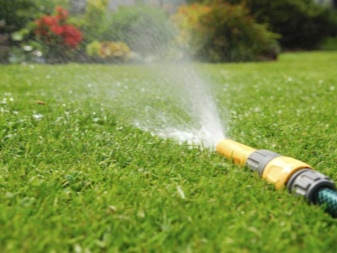

For information on how to water the lawn with your own hands, see the next video.



































































The comment was sent successfully.